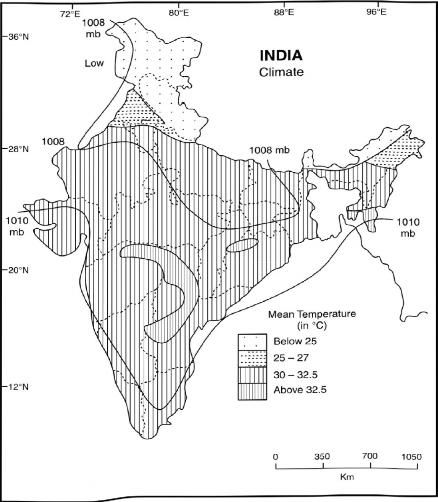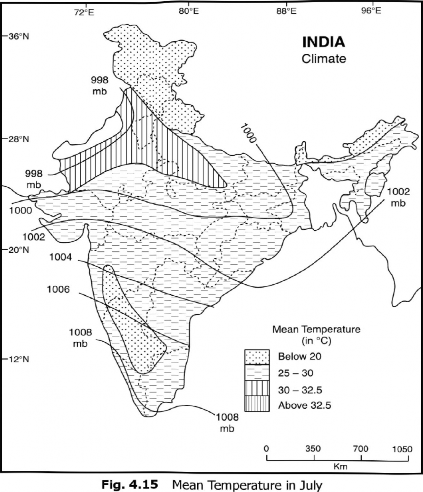2. The Hot Weather Season
The north Indian region experiences a well defined hot weather season from mid March to midJune. With the northward march of the sun towards the Tropic of Cancer after the vernal Equinox the temperature begins to rise. Thermal heating over north-western India gradually establishes a thermal ‘low’ at the surface but, while the jet stream remains south of the Himalayas, it maintains its dynamic anticyclone aloft over Afghanistan and the borderland of Pakistan. This ‘lid’ of subsiding warming dry air prevents the surface thermal ‘low’ from having sufficient effect as a lifting agent to carry air aloft and so to bring about precipitation (Johnson, 1969, p.17).
At the advent of March, the temperature starts rising abruptly. By April, the Peninsular regions south of the Vindhyan Range heat up with mean maximum temperature of 40°C. In May, the mean maximum temperature reaches 42°C in Rajasthan, Delhi, west Uttar Pradesh, south Punjab,

Fig-4.14 Mean Temperature in April
and reaches Kolkata around 111*1 June. In Delhi, western Uttar Pradesh, Haryana, and Punjab, the monsoon reaches around 1st July.

During the season of general rains, most of the country experiences good cloud cover (from 1/ 8 to overcast sky). During this season, the relative humidity is generally over 65 per cent. Assam and Kerala record the highest percentage of relative humidity; over 80 per cent over the greater part of the rainy season.
The greater parts of the subcontinent of India receive over 85 per cent of their total rainfall during the season oi general rains. The Arabian Sea current causes rainfall all along the Malabar coast, Konkan coast. Western Ghats, Maharashtra, Gujarat, and parts of Madhya Pradesh. Mumbai records about 190 cm of rainfall during this season. As the Arabian current crosses the Sahyadris, the places situated on the leeward side of the Western Ghats receive substantially less rainfall. For example, Pune (about 160 km to the east of Mumbai) gets only 125 cm of rainfall. Nagpur records Jammu city and Haryana. Temperature exceeding 54°C was recorded at Sri Ganganagar in 1967. At some places, particularly in north-western India, day temperature may be as high as 45°C or 47°C. The mean minimum daily temperature in May also remains quite high being about 26°C at Delhi and Jaipur. The temperature in the eastern states of India and in the hilly regions in the month of May is generally cool and invigorating (Fig. 4.14).
In the month of April the 30°C isotherm of average temperature encloses a vast area of the country between 1()°N and 26°N latitudes (except the west coast and the hilly states of north -east India). The diurnal range of temperature ranges between 5°C and 6°C in coastal areas, but reaches 20°C in the interior parts of the country and in the north-west Salluj Ganga Plains.
Being a transitional season between the north-east and the south-west monsoon (rainy season), it is characterised by unstable air pressure and wind circulation. With the northward movement of the sun, the low pressure area also moves from south-east to north-west. It finally settles over northwestern India in the end of May or early part of June. The pressure generally increases towards south in the neighbouring sea. The general direction of winds is from north-west and west in north western India; from south-west in the Arabian Sea and the adjoining coasts. The tornado-like dust storms of Punjab, Haryana, and western Uttar Pradesh, the hot winds (Loo) in western India, the Norwesters (Kalbaisakhis) of West Bengal are the characteristics of summer season.
During summer season, the Sun is scorching and the relative humidity is generally below 30 per cent, occasionally reaching below 10 per cent. The total rainfall of the season is below 2 cm in Rajasthan, Gujarat, Madhya Pradesh; between 5 and 1.5 cm in the sub montane region of Uttarakhand, Himachal Pradesh, Punjab, Bihar and Odisha; and between 15 and 25 cm in the Malabar coast and over 50 cm in Assam, Meghalaya, Mizoram, and Nagaland. The rains caused by thunderstorms in Karnataka are called as ‘Cherry Blossoms’ (where these are beneficial for coffee plantation) and elsewhere in south India as ‘mango showers’.
